Validation of Three Daily Satellite Rainfall Products in a Humid Tropic Watershed, Brantas, Indonesia: Implications to Land Characteristics and Hydrological Modelling
Abstract
:1. Introduction
2. Materials and Methods
2.1. Study Area
2.2. Satellite Rainfall Data Acquisition and Processing
2.3. Ground Rainfall Data Acquisition and Processing
2.4. Accuracy Assessment of Three Satellite Rainfall Estimates
2.4.1. Quantitative Assessment
2.4.2. Qualitative Assessment
2.5. Association of Errors to Varying Ecological Variables
2.6. Impacts of Satellite Rainfall Products on Hydrological Response Outputs
2.6.1. Model Description, Input, and Model Setup
2.6.2. Model Performance Evaluation
3. Results
3.1. Accuracy Assessment Results
3.1.1. Descriptive Statistics of Satellite Rainfall Data
3.1.2. Quantitative Accuracy Assessments
3.1.3. Quantitative Accuracy Assessments
3.2. Influence of Varying Ecological Variables to Errors of Satellite Products
3.3. Assessment of Satellite Products as Inputs for Hydrological Modeling
3.3.1. Accuracy and Uncertainty Performance of the SWAT Models
3.3.2. Impacts on Water Balance Components
4. Discussion
5. Conclusions
Author Contributions
Funding
Data Availability Statement
Acknowledgments
Conflicts of Interest
References
- Konapala, G.; Mishra, A.K.; Wada, Y.; Mann, M.E. Climate change will affect global water availability through compounding changes in seasonal precipitation and evaporation. Nat. Commun. 2020, 11, 3044. [Google Scholar] [CrossRef]
- Gherardi, L.A.; Sala, O.E. Effect of interannual precipitation variability on dryland productivity: A global synthesis. Glob. Chang. Biol. 2019, 25, 269–276. [Google Scholar] [CrossRef] [Green Version]
- Verón, S.R.; de Abelleyra, D.; Lobell, D.B. Impacts of precipitation and temperature on crop yields in the Pampas. Clim. Chang. 2015, 130, 235–245. [Google Scholar] [CrossRef] [Green Version]
- Terribile, F.; Agrillo, A.; Bonfante, A.; Buscemi, G.; Colandrea, M.; D’Antonio, A.; De Mascellis, R.; De Michele, C.; Langella, G.; Manna, P.; et al. A Web-based spatial decision supporting system for land management and soil conservation. Solid Earth 2015, 6, 903–928. [Google Scholar] [CrossRef] [Green Version]
- Ji, T.; Yang, H.; Liu, R.; He, T.; Wu, J. Applicability analysis of the TRMM precipitation data in the Sichuan-Chongqing region. Prog. Geogr. 2014, 33, 1375–1386. [Google Scholar]
- Ly, S.; Charles, C.; Degre, A. Geostatistical interpolation of daily rainfall at catchment scale: The use of several variogram models in the Ourthe and Ambleve catchments, Belgium. Hydrol. Earth Syst. Sci. 2011, 15, 2259–2274. [Google Scholar] [CrossRef] [Green Version]
- Mair, A.; Fares, A. Comparison of rainfall interpolation methods in a mountainous region of a tropical island. J. Hydrol. Eng. 2011, 16, 371–383. [Google Scholar] [CrossRef]
- Chowdhury, M.A.I.; Kabir, M.M.; Sayed, A.F.; Hossain, S. Estimation of rainfall patterns in Bangladesh using different computational methods (arithmetic average, thiessen polygon and isohyet). J. Biodivers. Environ. Sci. 2016, 8, 43–51. [Google Scholar]
- Zubieta, R.; Getirana, A.; Espinoza, J.C.; Lavado-Casimiro, W.; Aragon, L. Hydrological modeling of the Peruvian–Ecuadorian Amazon Basin using GPM-IMERG satellite-based precipitation dataset. Hydrol. Earth Syst. Sci. 2017, 21, 3543–3555. [Google Scholar] [CrossRef] [PubMed] [Green Version]
- Gebremichael, M.; Bitew, M.M.; Hirpa, F.A.; Tesfay, G.N. Accuracy of satellite rainfall estimates in the B lue N ile B asin: L owland plain versus highland mountain. Water Resour. Res. 2014, 50, 8775–8790. [Google Scholar] [CrossRef]
- Syed, K.H.; Goodrich, D.C.; Myers, D.E.; Sorooshian, S. Spatial characteristics of thunderstorm rainfall fields and their relation to runoff. J. Hydrol. 2003, 271, 1–21. [Google Scholar] [CrossRef] [Green Version]
- Fekete, B.M.; Vörösmarty, C.J.; Roads, J.O.; Willmott, C.J. Uncertainties in precipitation and their impacts on runoff estimates. J. Clim. 2004, 17, 294–304. [Google Scholar] [CrossRef]
- McMillan, H.; Jackson, B.; Clark, M.; Kavetski, D.; Woods, R. Rainfall uncertainty in hydrological modelling: An evaluation of multiplicative error models. J. Hydrol. 2011, 400, 83–94. [Google Scholar] [CrossRef]
- Michaelides, S.; Levizzani, V.; Anagnostou, E.; Bauer, P.; Kasparis, T.; Lane, J.E. Precipitation: Measurement, remote sensing, climatology and modeling. Atmos. Res. 2009, 94, 512–533. [Google Scholar] [CrossRef]
- Levizzani, V.; Cattani, E. Satellite remote sensing of precipitation and the terrestrial water cycle in a changing climate. Remote Sens. 2019, 11, 2301. [Google Scholar] [CrossRef] [Green Version]
- Bharti, V.; Singh, C. Evaluation of error in TRMM 3B42V7 precipitation estimates over the Himalayan region. J. Geophys. Res. Atmos. 2015, 120, 12458–12473. [Google Scholar] [CrossRef]
- Rahmawati, N.; Lubczynski, M.W. Validation of satellite daily rainfall estimates in complex terrain of Bali Island, Indonesia. Theor. Appl. Climatol. 2018, 134, 513–532. [Google Scholar] [CrossRef] [Green Version]
- Bitew, M.M.; Gebremichael, M. Assessment of satellite rainfall products for streamflow simulation in medium watersheds of the Ethiopian highlands. Hydrol. Earth Syst. Sci. 2011, 15, 1147–1155. [Google Scholar] [CrossRef] [Green Version]
- Vernimmen, R.R.E.; Hooijer, A.; Aldrian, E.; Van Dijk, A. Evaluation and bias correction of satellite rainfall data for drought monitoring in Indonesia. Hydrol. Earth Syst. Sci. 2012, 16, 133–146. [Google Scholar] [CrossRef] [Green Version]
- Greene, J.S.; Morrissey, M.L. xxxxxxValidation and Uncertainty Analysis of Satellite Rainfall Algorithms. Prof. Geogr. 2000, 52, 247–258. [Google Scholar] [CrossRef]
- Seo, B.-C.; Krajewski, W.F. Correcting temporal sampling error in radar-rainfall: Effect of advection parameters and rain storm characteristics on the correction accuracy. J. Hydrol. 2015, 531, 272–283. [Google Scholar] [CrossRef]
- Gebregiorgis, A.S.; Hossain, F. Understanding the dependence of satellite rainfall uncertainty on topography and climate for hydrologic model simulation. IEEE Trans. Geosci. Remote Sens. 2012, 51, 704–718. [Google Scholar] [CrossRef]
- Gao, Y.C.; Liu, M. Evaluation of high-resolution satellite precipitation products using rain gauge observations over the Tibetan Plateau. Hydrol. Earth Syst. Sci. 2013, 17, 837–849. [Google Scholar] [CrossRef] [Green Version]
- Xu, S.; Wu, C.; Wang, L.; Gonsamo, A.; Shen, Y.; Niu, Z. A new satellite-based monthly precipitation downscaling algorithm with non-stationary relationship between precipitation and land surface characteristics. Remote Sens. Environ. 2015, 162, 119–140. [Google Scholar] [CrossRef]
- Wohl, E.; Barros, A.; Brunsell, N.; Chappell, N.A.; Coe, M.; Giambelluca, T.; Goldsmith, S.; Harmon, R.; Hendrickx, J.M.H.; Juvik, J. The hydrology of the humid tropics. Nat. Clim. Chang. 2012, 2, 655–662. [Google Scholar] [CrossRef]
- Vimont, D.J.; Battisti, D.S.; Naylor, R.L. Downscaling Indonesian precipitation using large-scale meteorological fields. Int. J. Climatol. 2010, 30, 1706–1722. [Google Scholar] [CrossRef]
- As-syakur, A.R.; Tanaka, T.; Osawa, T.; Mahendra, M.S. Indonesian rainfall variability observation using TRMM multi-satellite data. Int. J. Remote Sens. 2013, 34, 7723–7738. [Google Scholar] [CrossRef]
- Rahmawati, N.; Rahayu, K.; Yuliasari, S.T. Performance of daily satellite-based rainfall in groundwater basin of Merapi Aquifer System, Yogyakarta. Theor. Appl. Climatol. 2021, 146, 173–190. [Google Scholar] [CrossRef]
- Funk, C.; Peterson, P.; Landsfeld, M.; Pedreros, D.; Verdin, J.; Shukla, S.; Husak, G.; Rowland, J.; Harrison, L.; Hoell, A.; et al. The climate hazards infrared precipitation with stations—A new environmental record for monitoring extremes. Sci. Data 2015, 2. [Google Scholar] [CrossRef] [Green Version]
- Bai, L.; Shi, C.; Li, L.; Yang, Y.; Wu, J. Accuracy of CHIRPS satellite-rainfall products over mainland China. Remote Sens. 2018, 10, 362. [Google Scholar] [CrossRef] [Green Version]
- Hou, A.Y.; Kakar, R.K.; Neeck, S.; Azarbarzin, A.A.; Kummerow, C.D.; Kojima, M.; Oki, R.; Nakamura, K.; Iguchi, T. The global precipitation measurement mission. Bull. Am. Meteorol. Soc. 2014, 95, 701–722. [Google Scholar] [CrossRef]
- Satgé, F.; Hussain, Y.; Bonnet, M.P.; Hussain, B.M.; Martinez-Carvajal, H.; Akhter, G.; Uagoda, R. Benefits of the successive GPM based Satellite Precipitation Estimates IMERG-V03, -V04, -V05 and GSMaP-V06, -V07 over diverse geomorphic and meteorological regions of Pakistan. Remote Sens. 2018, 10, 1373. [Google Scholar] [CrossRef] [Green Version]
- Tan, J.; Petersen, W.A.; Kirstetter, P.E.; Tian, Y. Performance of IMERG as a function of spatiotemporal scale. J. Hydrometeorol. 2017, 18, 307–319. [Google Scholar] [CrossRef] [PubMed]
- Tan, J.; Huffman, G.J. Computing Morphing Vectors for Version 06 IMERG; NASA: Greenbelt, MD, USA, 2019.
- Sun, S.; Zhou, S.; Shen, H.; Chai, R.; Chen, H.; Liu, Y.; Shi, W.; Wang, J.; Wang, G.; Zhou, Y. Dissecting performances of PERSIANN-CDR precipitation product over Huai River Basin, China. Remote Sens. 2019, 11, 1805. [Google Scholar] [CrossRef] [Green Version]
- Xie, P.; Janowiak, J.E.; Arkin, P.A.; Adler, R.; Gruber, A.; Ferraro, R.; Huffman, G.J.; Curtis, S. GPCP pentad precipitation analyses: An experimental dataset based on gauge observations and satellite estimates. J. Clim. 2003, 16, 2197–2214. [Google Scholar] [CrossRef] [Green Version]
- Ashouri, H.; Hsu, K.L.; Sorooshian, S.; Braithwaite, D.K.; Knapp, K.R.; Cecil, L.D.; Nelson, B.R.; Prat, O.P. PERSIANN-CDR: Daily precipitation climate data record from multisatellite observations for hydrological and climate studies. Bull. Am. Meteorol. Soc. 2015, 96, 69–83. [Google Scholar] [CrossRef] [Green Version]
- Nguyen, P.; Thorstensen, A.; Sorooshian, S.; Zhu, Q.; Tran, H.; Ashouri, H.; Miao, C.; Hsu, K.; Gao, X. Evaluation of CMIP5 model precipitation using PERSIANN-CDR. J. Hydrometeorol. 2017, 18, 2313–2330. [Google Scholar] [CrossRef]
- Sorooshian, S.; Hsu, K.; Braithwaite, D.; Ashouri, H. NOAA CDR Program NOAA Climate Data Record (CDR) of Precipitation Estimation from Remotely Sensed Information Using Artificial Neural Networks (PERSIANN-CDR), Version 1, Revision 1. Available online: https://www.ncei.noaa.gov/metadata/geoportal/rest/metadata/item/gov.noaa.ncdc:C00854/html# (accessed on 16 July 2021).
- Sahlu, D.; Nikolopoulos, E.I.; Moges, S.A.; Anagnostou, E.N.; Hailu, D. First evaluation of the Day-1 IMERG over the upper Blue Nile basin. J. Hydrometeorol. 2016, 17, 2875–2882. [Google Scholar] [CrossRef]
- Tang, G.; Zeng, Z.; Long, D.; Guo, X.; Yong, B.; Zhang, W.; Hong, Y. Statistical and hydrological comparisons between TRMM and GPM Level-3 products over a midlatitude Basin: Is day-1 IMERG a good successor for TMPA 3B42V7? J. Hydrometeorol. 2016, 17, 121–137. [Google Scholar] [CrossRef]
- Tan, M.L.; Duan, Z. Assessment of GPM and TRMM precipitation products over Singapore. Remote Sens. 2017, 9, 720. [Google Scholar] [CrossRef] [Green Version]
- Xu, R.; Tian, F.; Yang, L.; Hu, H.; Lu, H.; Hou, A. Ground validation of GPM IMERG and TRMM 3B42V7 rainfall products over southern Tibetan Plateau based on a high-density rain gauge network. J. Geophys. Res. Atmos. 2017, 122, 910–924. [Google Scholar] [CrossRef]
- Paredes-Trejo, F.J.; Barbosa, H.A.; Kumar, T.V.L. Validating CHIRPS-based satellite precipitation estimates in Northeast Brazil. J. Arid Environ. 2017, 139, 26–40. [Google Scholar] [CrossRef]
- Dinku, T.; Funk, C.; Peterson, P.; Maidment, R.; Tadesse, T.; Gadain, H.; Ceccato, P. Validation of the CHIRPS satellite rainfall estimates over eastern Africa. Q. J. R. Meteorol. Soc. 2018, 144, 292–312. [Google Scholar] [CrossRef] [Green Version]
- Buitink, J.; Melsen, L.A.; Kirchner, J.W.; Teuling, A.J. A distributed simple dynamical systems approach (dS2 v1.0) for computationally efficient hydrological modelling at high spatio-temporal resolution. Geosci. Model Dev. 2020, 13, 6093–6110. [Google Scholar] [CrossRef]
- Amiri, M.; Tarkesh, M.; Jafari, R.; Jetschke, G. Bioclimatic variables from precipitation and temperature records vs. remote sensing-based bioclimatic variables: Which side can perform better in species distribution modeling? Ecol. Inform. 2020, 57, 101060. [Google Scholar] [CrossRef]
- Mishra, A.K.; Ines, A.V.M.; Das, N.N.; Prakash Khedun, C.; Singh, V.P.; Sivakumar, B.; Hansen, J.W. Anatomy of a local-scale drought: Application of assimilated remote sensing products, crop model, and statistical methods to an agricultural drought study. J. Hydrol. 2015, 526, 15–29. [Google Scholar] [CrossRef]
- Astuti, I.S.; Sahoo, K.; Milewski, A.; Mishra, D.R. Impact of Land Use Land Cover (LULC) Change on Surface Runoff in an Increasingly Urbanized Tropical Watershed. Water Resour. Manag. 2019, 33, 4087–4103. [Google Scholar] [CrossRef]
- Nash, J.E.; Sutcliffe, J.V. River flow forecasting through conceptual models part I—A discussion of principles. J. Hydrol. 1970, 10, 282–290. [Google Scholar] [CrossRef]
- Beven, K.; Freer, J. Equifinality, data assimilation, and uncertainty estimation in mechanistic modelling of complex environmental systems using the GLUE methodology. J. Hydrol. 2001, 249, 11–29. [Google Scholar] [CrossRef]
- Yen, H.; Wang, X.; Fontane, D.G.; Harmel, R.D.; Arabi, M. A framework for propagation of uncertainty contributed by parameterization, input data, model structure, and calibration/validation data in watershed modeling. Environ. Model. Softw. 2014, 54, 211–221. [Google Scholar] [CrossRef]
- Zhao, F.; Wu, Y.; Qiu, L.; Sun, Y.; Sun, L.; Li, Q.; Niu, J.; Wang, G. Parameter uncertainty analysis of the SWAT model in a mountain-loess transitional watershed on the Chinese Loess Plateau. Water 2018, 10, 690. [Google Scholar] [CrossRef] [Green Version]
- Wu, H.; Chen, B. Evaluating uncertainty estimates in distributed hydrological modeling for the Wenjing River watershed in China by GLUE, SUFI-2, and ParaSol methods. Ecol. Eng. 2015, 76, 110–121. [Google Scholar] [CrossRef]
- Abbaspour, K.C. SWAT Calibration and Uncertainty Programs—A User Manual; Swiss Federal Institute of Aquatic Science and Technology: Eawag, Switzerland, 2015; Available online: https://swat.tamu.edu/media/114860/usermanual_swatcup.pdf (accessed on 3 August 2021).
- Moriasi, D.N.; Arnold, J.G.; Van Liew, M.W.; Bingner, R.L.; Harmel, R.D.; Veith, T.L. Model evaluation guidelines for systematic quantification of accuracy in watershed simulations. Trans. ASABE 2007, 50, 885–900. [Google Scholar] [CrossRef]
- Mahmud, M.R.; Hashim, M.; Reba, M.N.M. How effective is the new generation of GPM satellite precipitation in characterizing the rainfall variability over Malaysia? Asia-Pacific J. Atmos. Sci. 2017, 53, 375–384. [Google Scholar] [CrossRef]
- Cavalcante, R.B.L.; da Silva Ferreira, D.B.; Pontes, P.R.M.; Tedeschi, R.G.; da Costa, C.P.W.; de Souza, E.B. Evaluation of extreme rainfall indices from CHIRPS precipitation estimates over the Brazilian Amazonia. Atmos. Res. 2020, 238, 104879. [Google Scholar] [CrossRef]
- Manz, B.; Páez-Bimos, S.; Horna, N.; Buytaert, W.; Ochoa-Tocachi, B.; Lavado-Casimiro, W.; Willems, B. Comparative ground validation of IMERG and TMPA at variable spatiotemporal scales in the tropical Andes. J. Hydrometeorol. 2017, 18, 2469–2489. [Google Scholar] [CrossRef]
- Austin, G.L.; Dirks, K.N. Topographic Effects on Precipitation. In Encyclopedia of Hydrological Sciences; John Wiley and Sons: West Sussex, UK, 2005. [Google Scholar]
- Zhao, Y. Diurnal variation of rainfall associated with tropical depression in South China and its relationship to land-sea contrast and topography. Atmosphere 2014, 5, 16. [Google Scholar] [CrossRef] [Green Version]
- Case, M.; Ardiansyah, F.; Spector, E. Climate Change in Indonesia Implications for Humans and Nature. Energy WWF Reports. 2007. Available online: https://wwf.panda.org/wwf_news/?118240/Climate-Change-in-Indonesia-Implications-for-Humans-and-Nature (accessed on 15 August 2021).
- Liu, C.; Zipser, E.J. “Warm rain” in the tropics: Seasonal and regional distributions based on 9 yr of TRMM data. J. Clim. 2009, 22, 767–779. [Google Scholar] [CrossRef] [Green Version]
- Back, L.E.; Bretherton, C.S. The relationship between wind speed and precipitation in the Pacific ITCZ. J. Clim. 2005, 18, 4317–4328. [Google Scholar] [CrossRef]
- Varma, A.K. Measurement of Precipitation from Satellite Radiometers (Visible, Infrared, and Microwave): Physical Basis, Methods, and Limitations. In Remote Sensing of Aerosols, Clouds, and Precipitation; Elsevier Inc.: Amsterdam, The Netherlands, 2018. [Google Scholar]
- Huffman, G.J.; Bolvin, D.T.; Braithwaite, D.; Hsu, K.; Joyce, R. Algorithm Theoretical Basis Document (ATBD) NASA Global Precipitation Measurement (GPM) Integrated Multi-Satellite Retrievals for GPM (IMERG); National Aeronautics and Space Administration: Washington, DC, USA, 2015.
- Li, M.; Shao, Q. An improved statistical approach to merge satellite rainfall estimates and raingauge data. J. Hydrol. 2010, 385, 51–64. [Google Scholar] [CrossRef]
- Lazri, M.; Labadi, K.; Brucker, J.M.; Ameur, S. Improving satellite rainfall estimation from MSG data in Northern Algeria by using a multi-classifier model based on machine learning. J. Hydrol. 2020, 584, 124705. [Google Scholar] [CrossRef]
- Tuo, Y.; Duan, Z.; Disse, M.; Chiogna, G. Evaluation of precipitation input for SWAT modeling in Alpine catchment: A case study in the Adige river basin (Italy). Sci. Total Environ. 2016, 573, 66–82. [Google Scholar] [CrossRef] [Green Version]
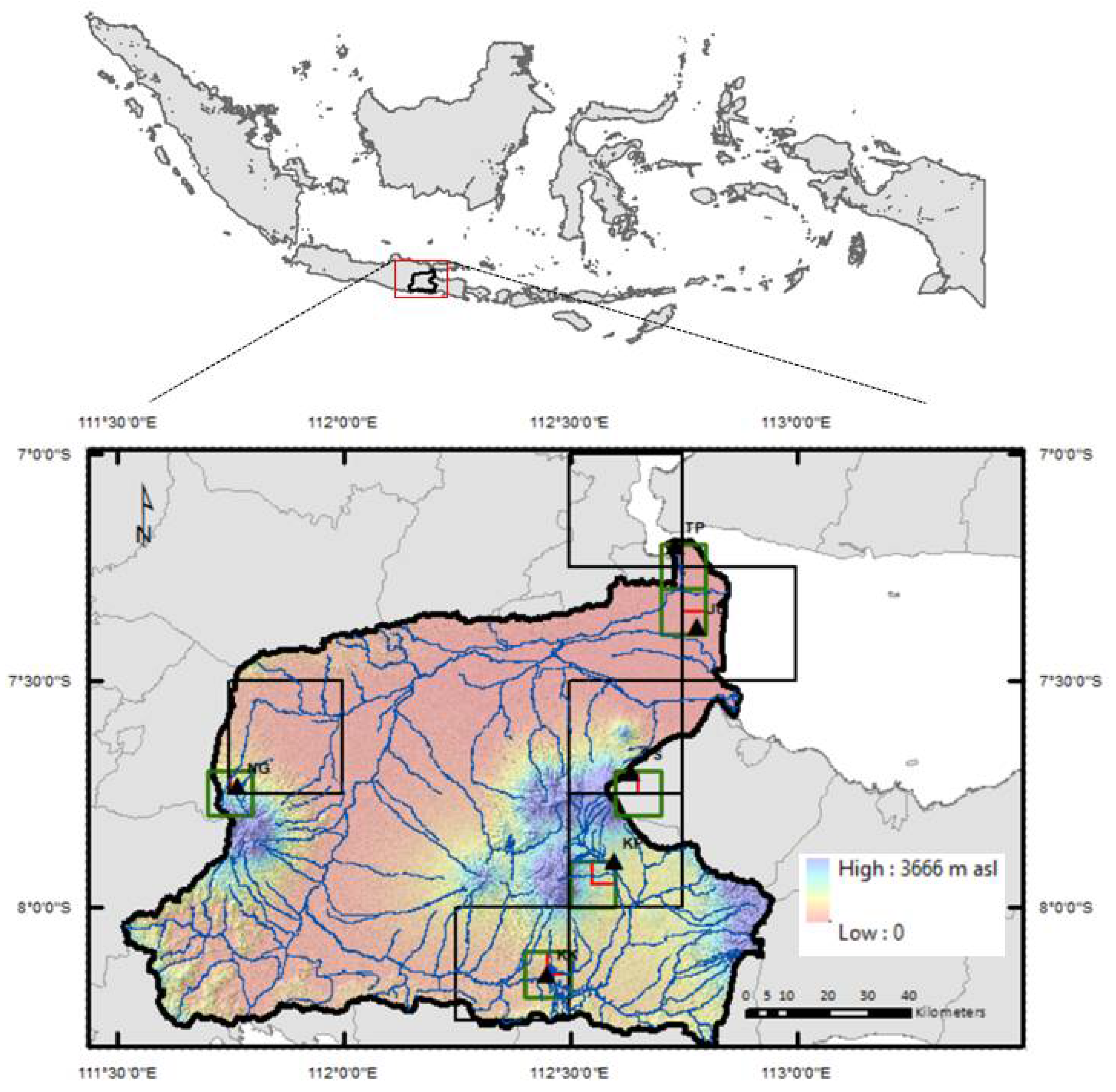



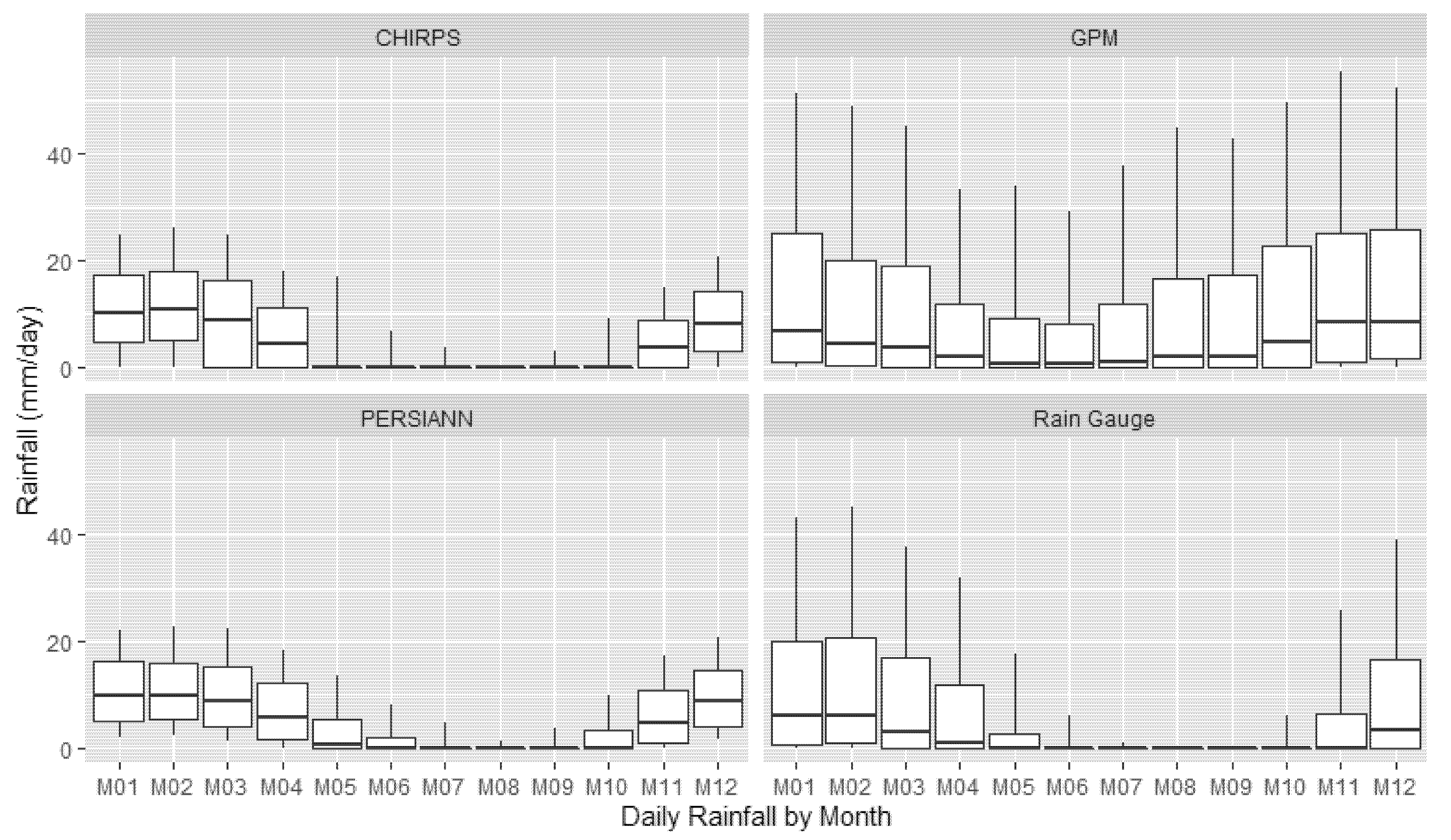
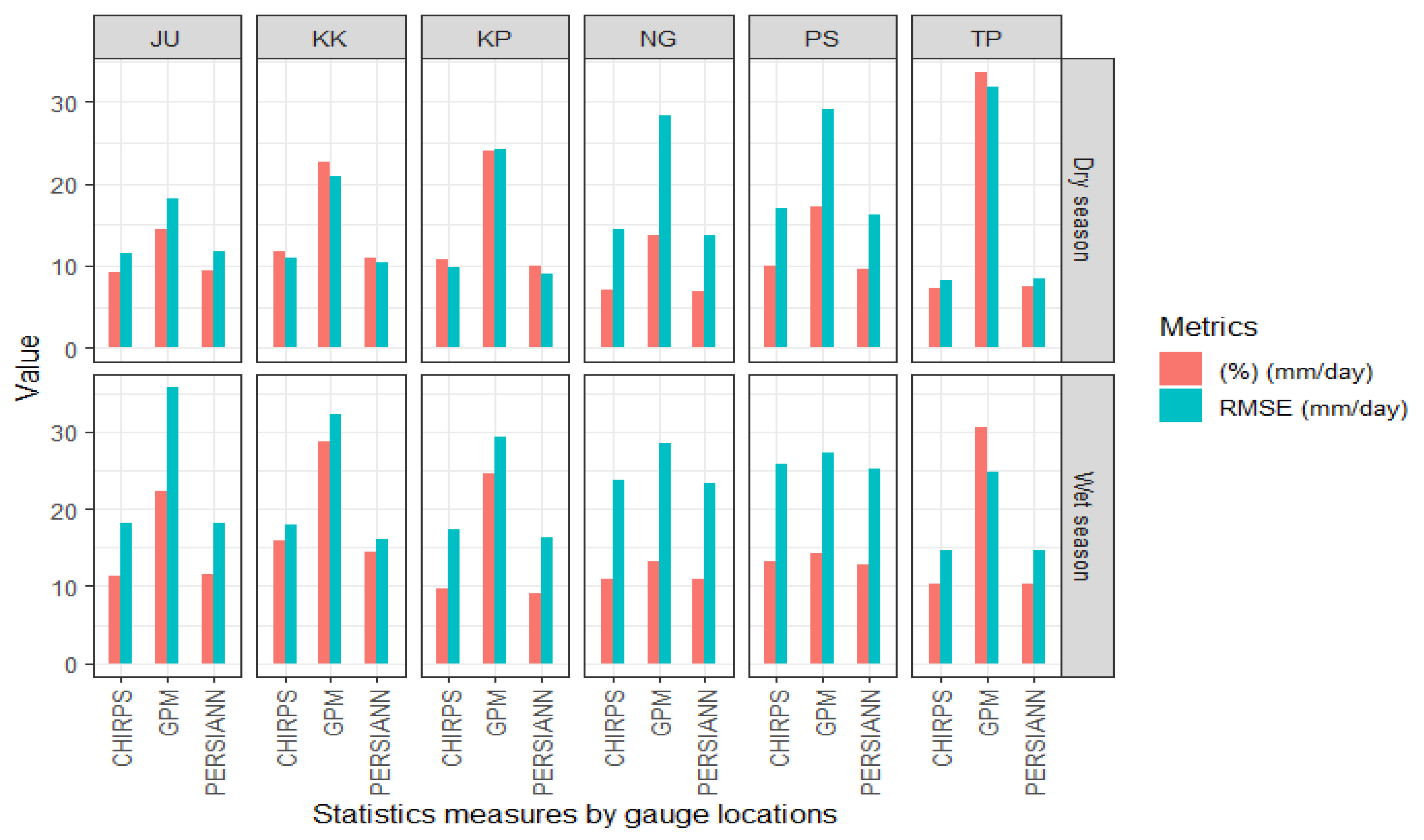


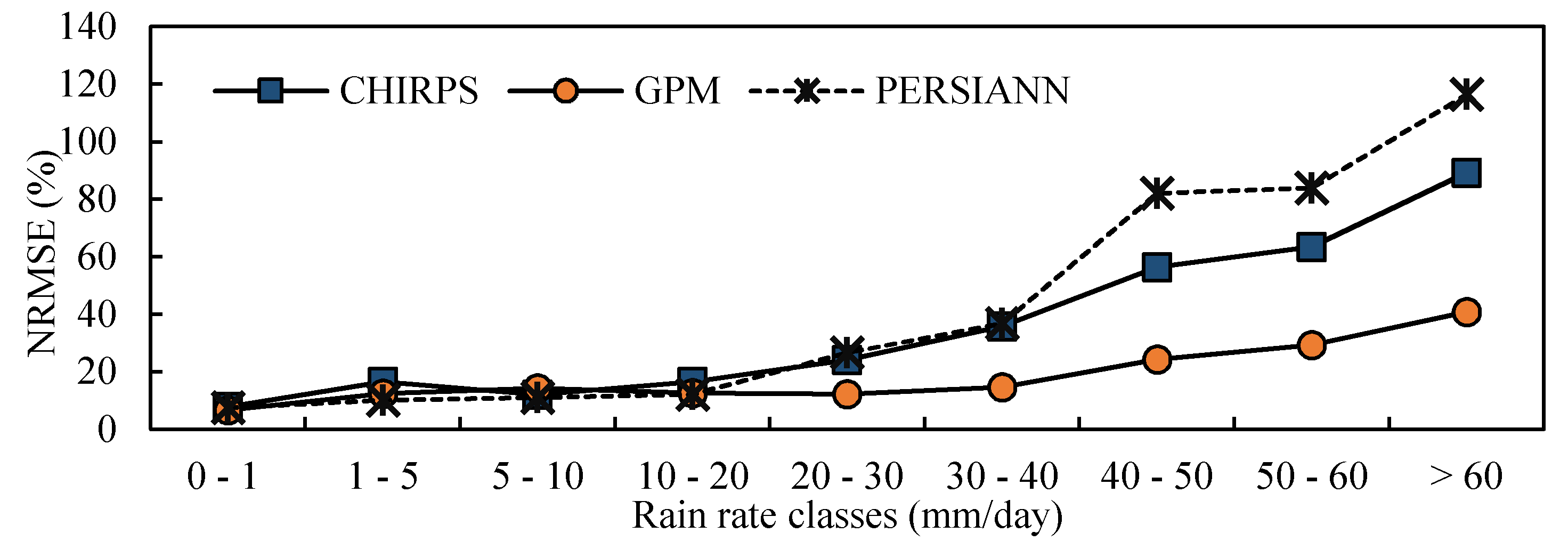

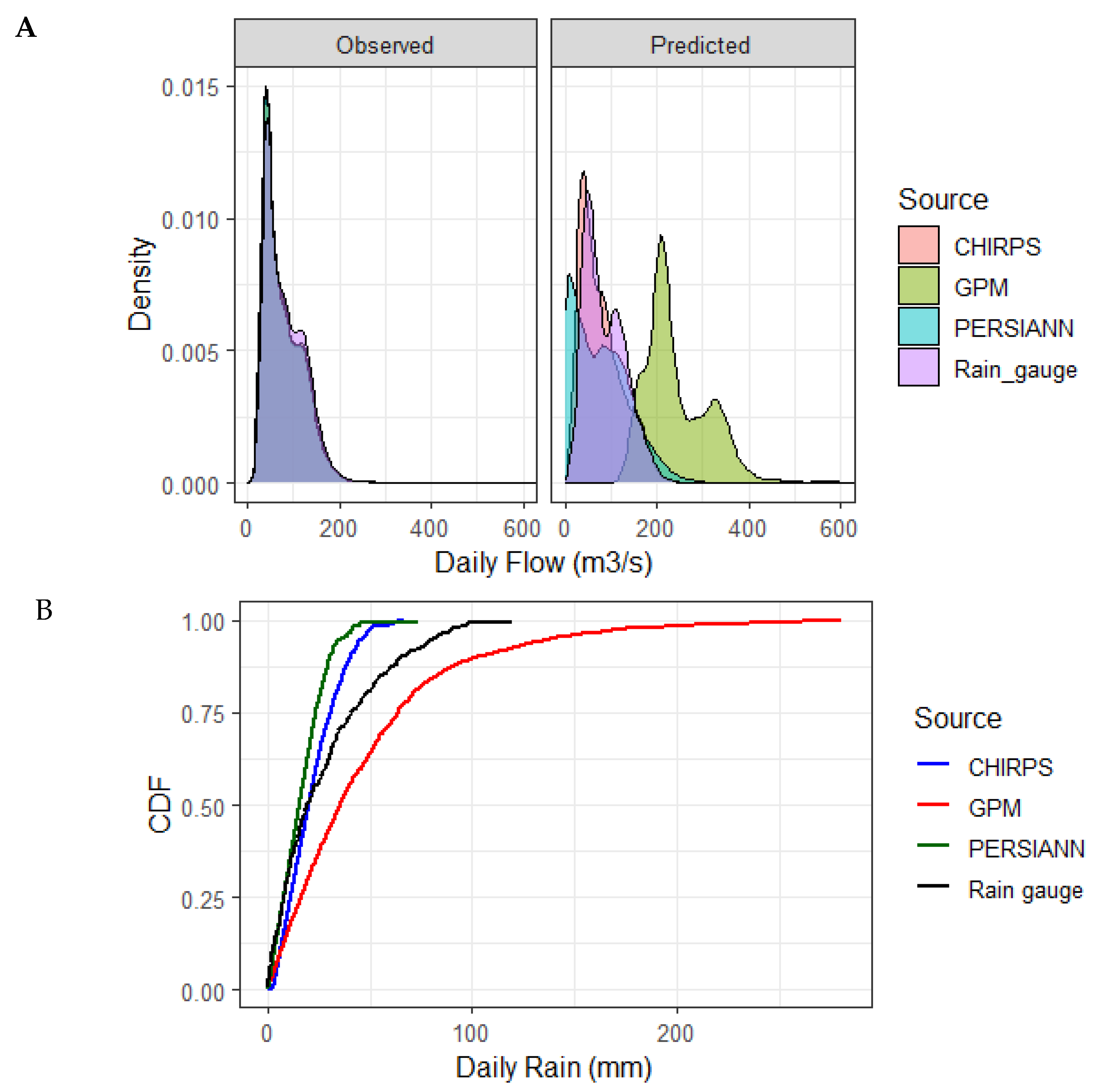
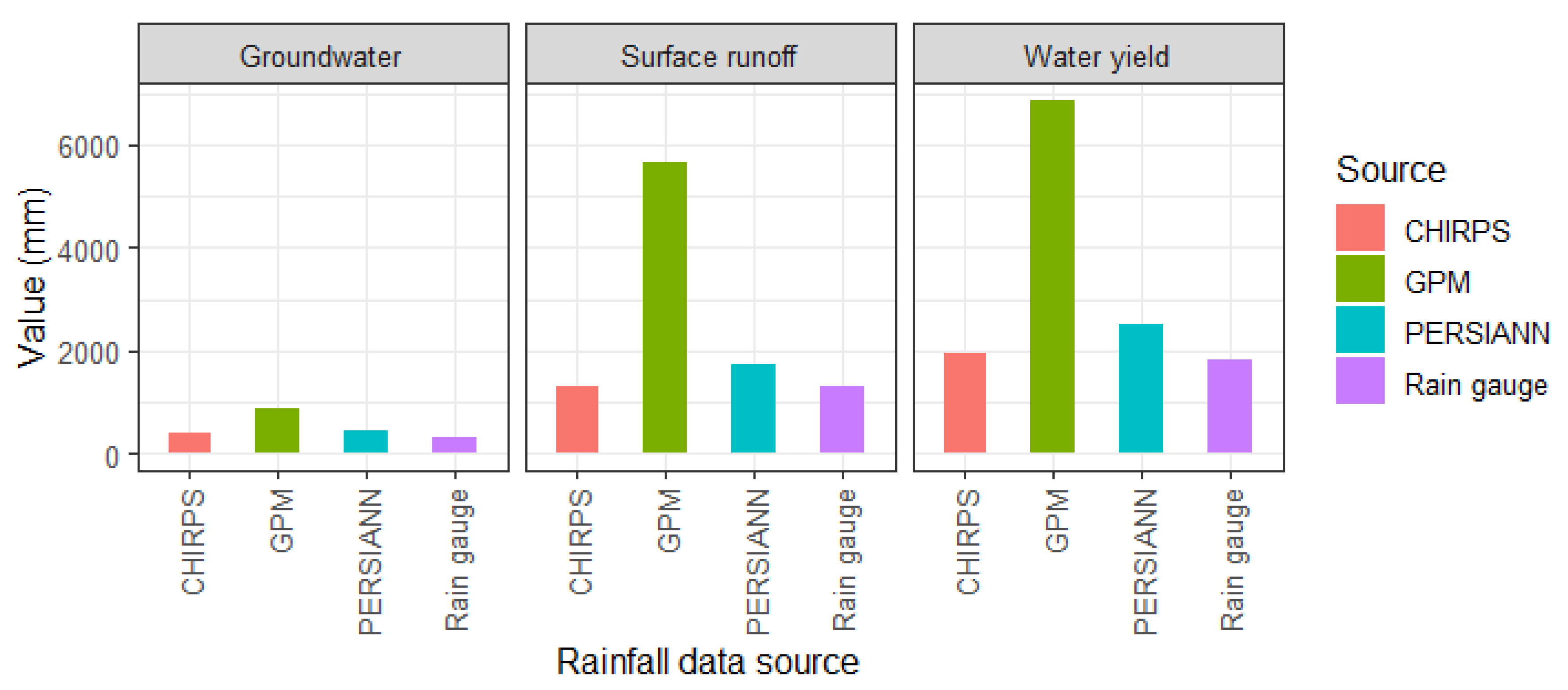
| Dataset | Advantages | Limitations |
|---|---|---|
| CHIRPS | Highest resolution, ~5 km, more suitable for detailed assessment in small areas with a short latency. Potential for smaller biases due to its higher resolution [29] | Larger data size per unit area due to higher spatial resolution. The IR brightness temperature-based algorithm included in CHIRPS is insensitive to rain affected by orographic effects, due to its low temperature clouds, and is moderately sensitive to precipitation from typhoon weather systems [30] |
| GPM-IMERG | GPM-IMERG combines intermittent precipitation estimates from all constellation microwave sensors, IR-based observations from geosynchronous satellites, and monthly gauge precipitation data [31] Available at a 0.1° and half–hourly and hourly temporal scales, respectively, they offer the opportunity for capturing finer local precipitation variations in space and time [32] | Over oceans, it is likely that the performance of IMERG will be better because of better microwave retrieval over the ocean, but poorer over mountainous areas [33] The geostationary IR from IMERG has two main limitations, which are the mismatch between IR-based cloud-top and surface precipitation motions, and the limited latitude coverage (60° N–S) caused by viewing angle limitation [34] |
| Ground data/rain gauge data | Ground-based rainfall measurements from gauges/radars often provide higher spatial and temporal sampling as well as the most direct measure of rainfall over many regions. Often such data are used for purposes of calibration [35] | Coverage might be limited, unevenly distributed, or sparsely distributed. High potential for recording errors due to lack of maintenance and low-skill gauge operators, and often limited by incomplete or missing data [36] |
| PERSIANN-CDR | Consistent, long-term data set with more than 30 years of data, updated quarterly [37] Given its coarse resolution, it is relatively suitable for large-scale (continental or national level assessment) and benefitted from smaller data size [38] | CDR version has daily temporal resolution, does not resolve the diurnal cycle, may not record some short-lived, intense events and is not independent of other precipitation estimates. Relies heavily on infrared data—conversion from IR to precipitation rate requires complex algorithm, not quite global (60° S–60° N) [37] |
| Gauge Locations | ||||||
|---|---|---|---|---|---|---|
| JU | KK | KP | NG | PS | TP | |
| Elevation (mean) | 2.3 | 326.4 | 649.3 | 584.7 | 1479.2 | 4.7 |
| Temperature range (°C) | 24–37 | 26–29 | 28–31 | 25–28 | 17–22 | 28–38 |
| Wind-speed range (m/s) | 2–5 | 2–5 | 2–5 | 2–5 | 2–5 | 2–5 |
| PET range (mm/day) | 0.6–1.7 | 0.8–1.7 | 0.6–1.7 | 0.8–1.8 | 0.1–1.8 | 0.1–1.8 |
| Total annual rainfall (mm) | 1567 | 1846 | 1576 | 2059 | 2373 | 1286 |
| Average daily rainfall rate (mm/day) | 4.8 | 5.6 | 5.2 | 6.2 | 8.4 | 4.0 |
| Rain Gauge (mm/day) | |||
| Rain > 0 mm/day | Rain = 0 mm/day | ||
| Satellite estimates | Rain > 0 mm/day | a (hits) | b (false) |
| Rain = 0 mm/day | c (misses) | d (correct no rain) | |
| Dataset | Source | Resolution |
|---|---|---|
| Mean and CV of Elevation (AV_EL, CV_EL) | ASTER DEM V2 | 30 m |
| Mean and CV of Slope (AV_SL, CV_SL) | ASTER DEM V2 | 30 m |
| Mean and CV of NDVI (NDVI) | MODIS | 500 m, daily, monthly aggregated |
| Mean potential evapotranspiration (PET) | MODIS 16-ET | 500 m, 8-day, monthly aggregated |
| Mean wind (Wind) | NOAA AVHRR | 5 km, daily, monthly aggregated |
| Mean temperature (Temp) | MODIS-LST | 1 km, daily, monthly aggregated |
| Level | Dataset * | CHIRPS | GPM | PERSIANN | |||||||||
|---|---|---|---|---|---|---|---|---|---|---|---|---|---|
| RMSE | CC | MAE | NRMSE | RMSE | CC | MAE | NRMSE | RMSE | CC | MAE | NRMSE | ||
| Daily (mm/day) | All-combined | 16.56 | 0.28 | 7.99 | 7.68 | 27.85 | 0.28 | 14.06 | 12.93 | 16.15 | 0.29 | 7.95 | 7.49 |
| JU | 15.17 | 0.28 | 7.15 | 9.52 | 28.19 | 0.22 | 12.93 | 17.70 | 15.28 | 0.26 | 7.54 | 9.59 | |
| KK | 14.95 | 0.31 | 8.40 | 13.35 | 27.30 | 0.37 | 13.17 | 24.38 | 13.62 | 0.32 | 7.47 | 12.16 | |
| KP | 14.07 | 0.23 | 7.45 | 7.82 | 27.02 | 0.21 | 14.45 | 22.52 | 13.21 | 0.26 | 7.05 | 7.34 | |
| NG | 19.72 | 0.28 | 9.24 | 9.15 | 28.36 | 0.37 | 13.45 | 13.16 | 19.24 | 0.31 | 9.13 | 8.93 | |
| PS | 21.93 | 0.26 | 11.20 | 11.13 | 28.09 | 0.30 | 16.03 | 14.78 | 21.32 | 0.31 | 10.73 | 10.82 | |
| TP | 11.80 | 0.36 | 5.56 | 8.28 | 28.63 | 0.23 | 15.40 | 30.30 | 11.86 | 0.35 | 6.05 | 8.32 | |
| Total Monthly rainfall (mm) | All-combined | 139.20 | 0.79 | 83.37 | 10.09 | 252.64 | 0.84 | 181.41 | 22.74 | 135.86 | 0.79 | 83.63 | 9.85 |
| JU | 104.93 | 0.86 | 67.17 | 11.84 | 258.38 | 0.89 | 188.20 | 29.16 | 97.83 | 0.84 | 65.72 | 11.04 | |
| KK | 113.58 | 0.77 | 86.85 | 21.59 | 294.48 | 0.90 | 230.71 | 55.98 | 80.04 | 0.85 | 54.19 | 15.22 | |
| KP | 88.91 | 0.81 | 61.47 | 13.72 | 314.92 | 0.84 | 230.30 | 61.39 | 86.54 | 0.81 | 60.16 | 13.36 | |
| NG | 178.93 | 0.79 | 111.87 | 18.04 | 192.93 | 0.94 | 143.92 | 18.90 | 169.81 | 0.84 | 110.60 | 17.12 | |
| PS | 221.90 | 0.84 | 151.26 | 16.08 | 159.65 | 0.90 | 117.09 | 14.37 | 224.26 | 0.87 | 153.22 | 16.25 | |
| TP | 60.69 | 0.88 | 39.16 | 11.92 | 319.88 | 0.90 | 255.40 | 67.51 | 66.91 | 0.87 | 49.12 | 13.16 | |
| Daily in wet season | All-combined | 19.91 | 0.22 | 11.44 | 9.24 | 30.77 | 0.24 | 16.77 | 14.28 | 19.51 | 0.22 | 11.35 | 9.05 |
| JU | 18.13 | 0.22 | 10.23 | 11.38 | 35.66 | 0.16 | 19.84 | 22.39 | 18.24 | 0.19 | 10.79 | 11.45 | |
| KK | 17.89 | 0.21 | 11.78 | 15.98 | 32.14 | 0.29 | 18.70 | 28.70 | 16.16 | 0.23 | 10.29 | 14.43 | |
| KP | 17.23 | 0.16 | 10.86 | 9.57 | 29.37 | 0.18 | 16.59 | 24.47 | 16.30 | 0.16 | 10.23 | 9.06 | |
| NG | 23.73 | 0.21 | 13.19 | 11.01 | 28.48 | 0.37 | 13.77 | 13.21 | 23.41 | 0.22 | 13.19 | 10.86 | |
| PS | 25.79 | 0.19 | 15.36 | 13.09 | 27.18 | 0.29 | 15.28 | 14.30 | 25.29 | 0.22 | 14.80 | 12.84 | |
| TP | 14.56 | 0.32 | 8.31 | 10.22 | 24.76 | 0.31 | 12.60 | 30.57 | 14.57 | 0.30 | 8.77 | 10.23 | |
| Daily in dry season | All-combined | 12.26 | 0.22 | 4.48 | 6.13 | 24.51 | 0.30 | 11.28 | 11.90 | 11.85 | 0.26 | 4.53 | 5.93 |
| JU | 11.55 | 0.26 | 4.12 | 9.20 | 18.24 | 0.22 | 6.24 | 14.54 | 11.73 | 0.24 | 4.39 | 9.34 | |
| KK | 10.99 | 0.37 | 4.80 | 11.82 | 20.99 | 0.45 | 7.31 | 22.57 | 10.28 | 0.36 | 4.49 | 11.05 | |
| KP | 9.76 | 0.19 | 3.91 | 10.85 | 24.27 | 0.23 | 12.16 | 24.03 | 8.97 | 0.23 | 3.79 | 9.97 | |
| NG | 14.41 | 0.25 | 5.12 | 6.99 | 28.23 | 0.37 | 13.12 | 13.71 | 13.69 | 0.32 | 4.96 | 6.84 | |
| PS | 17.00 | 0.21 | 6.86 | 10.06 | 29.02 | 0.29 | 16.84 | 17.17 | 16.24 | 0.30 | 6.54 | 9.61 | |
| TP | 8.27 | 0.27 | 2.88 | 7.27 | 31.74 | 0.17 | 17.94 | 33.59 | 8.47 | 0.31 | 3.43 | 7.44 | |
| Source | Dataset | Accuracy Measure | ||||
|---|---|---|---|---|---|---|
| POD | FOH | FAR | CSI | DA | ||
| CHIRPS | All-combined | 0.70 | 0.68 | 0.32 | 0.52 | 0.74 |
| Wet season | 0.78 | 0.72 | 0.28 | 0.60 | 0.70 | |
| Dry season | 0.46 | 0.53 | 0.47 | 0.33 | 0.78 | |
| GPM | All-combined | 0.96 | 0.54 | 0.46 | 0.52 | 0.63 |
| Wet season | 0.98 | 0.53 | 0.47 | 0.53 | 0.59 | |
| Dry season | 0.96 | 0.54 | 0.46 | 0.52 | 0.63 | |
| PERSIANN | All-combined | 0.91 | 0.60 | 0.40 | 0.57 | 0.72 |
| Wet season | 0.76 | 0.46 | 0.54 | 0.41 | 0.74 | |
| Dry season | 0.97 | 0.66 | 0.34 | 0.65 | 0.69 | |
| CHIRPS | GPM | PERSIANN | |
|---|---|---|---|
| Cv_NDVI | 0.04 | −0.03 | 0.05 |
| Av_NDVI | −0.05 | 0.16 | −0.10 |
| PET | −0.48 | −0.01 | −0.54 |
| Wind | −0.39 | 0.14 | −0.39 |
| Temp | −0.19 | 0.21 | −0.06 |
| Av_Slope | 0.29 | 0.16 | 0.29 |
| Cv_Slope | −0.19 | −0.17 | −0.17 |
| Av_Elevation | 0.22 | 0.20 | 0.21 |
| Cv_Elevation | −0.14 | 0.01 | 0.01 |
| Dataset | Calibration (2003–2008) | Validation (2009–2013) | ||||||
|---|---|---|---|---|---|---|---|---|
| R2 | NS | p-Factor | r-Factor | R2 | NSE | p-Factor | r-Factor | |
| Rain gauge | 0.75 | 0.74 | 0.97 | 1.96 | 0.74 | 0.73 | 0.93 | 0.94 |
| CHIRPS | 0.59 | 0.54 | 0.97 | 1.96 | 0.62 | 0.55 | 0.95 | 2.22 |
| GPM | 0.28 | −13.58 | 0.33 | 4.49 | 0.37 | −21.44 | 0.33 | 4.97 |
| PERSIANN | 0.47 | 0.35 | 0.92 | 1.7 | 0.61 | 0.55 | 0.88 | 1.84 |
| Component | Ratio to Gauge Value | ||
|---|---|---|---|
| CHIRPS | GPM | PERSIANN | |
| Surface runoff | 1.02 | 4.35 | 1.34 |
| Groundwater | 1.32 | 2.87 | 1.12 |
| Water yield | 1.08 | 3.80 | 1.40 |
Publisher’s Note: MDPI stays neutral with regard to jurisdictional claims in published maps and institutional affiliations. |
© 2021 by the authors. Licensee MDPI, Basel, Switzerland. This article is an open access article distributed under the terms and conditions of the Creative Commons Attribution (CC BY) license (https://creativecommons.org/licenses/by/4.0/).
Share and Cite
Wiwoho, B.S.; Astuti, I.S.; Alfarizi, I.A.G.; Sucahyo, H.R. Validation of Three Daily Satellite Rainfall Products in a Humid Tropic Watershed, Brantas, Indonesia: Implications to Land Characteristics and Hydrological Modelling. Hydrology 2021, 8, 154. https://doi.org/10.3390/hydrology8040154
Wiwoho BS, Astuti IS, Alfarizi IAG, Sucahyo HR. Validation of Three Daily Satellite Rainfall Products in a Humid Tropic Watershed, Brantas, Indonesia: Implications to Land Characteristics and Hydrological Modelling. Hydrology. 2021; 8(4):154. https://doi.org/10.3390/hydrology8040154
Chicago/Turabian StyleWiwoho, Bagus Setiabudi, Ike Sari Astuti, Imam Abdul Gani Alfarizi, and Hetty Rahmawati Sucahyo. 2021. "Validation of Three Daily Satellite Rainfall Products in a Humid Tropic Watershed, Brantas, Indonesia: Implications to Land Characteristics and Hydrological Modelling" Hydrology 8, no. 4: 154. https://doi.org/10.3390/hydrology8040154
APA StyleWiwoho, B. S., Astuti, I. S., Alfarizi, I. A. G., & Sucahyo, H. R. (2021). Validation of Three Daily Satellite Rainfall Products in a Humid Tropic Watershed, Brantas, Indonesia: Implications to Land Characteristics and Hydrological Modelling. Hydrology, 8(4), 154. https://doi.org/10.3390/hydrology8040154





